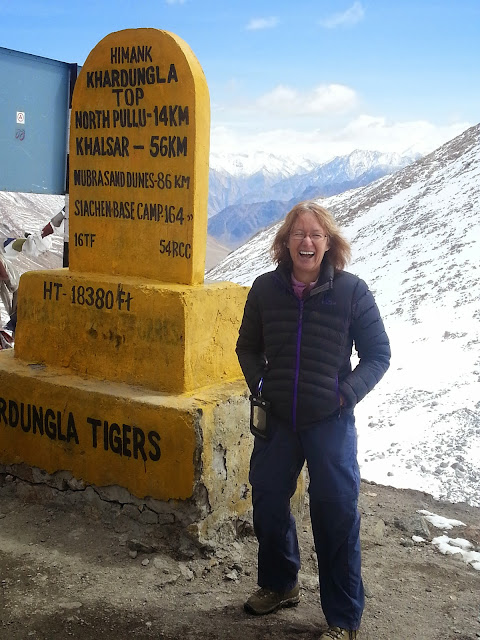The great silk route once wound its way through the Nubra valley, from India to Eastern Turkistan with caravans of camels carrying spices, pashminas and silk. For our last excursion in Ladakh we followed the silk road as far as it would take us. Bryan really wanted to take the bike but with the highest road pass in the world to negotiate I wasn't too keen and anyhow we got to share a jeep with a lovely Israeli couple, Ori and Shira, and fellow Kiwi Dave.
From Leh the road zigzagged and twisted up through mud, rocks, snow and ice to the impressive Khardung-La pass which at 5602m is probably as high as I'll ever go and still be on land. We then dropped down the over side, past fields of yaks, to the beautiful Nubra valley. Divided in two by a turquoise river and jade river the colors were dramatic and between barren hills burst pockets of emerald green where the apricots flourished. We stopped at Diskit monastery where a huge Buddha guarded the valley and watched dust storms dance across the dunes below. But not only Buddha guarded the way to Pakistan. Army camps, bunkers and barracks littered the dunes and we were stopped 3 times on our journey for passport and permit checks.
The road took us through chasms and gorges and sheer mountain slopes of grey granite, silver shale and red rubble. Boulders the size of cars were strewn carelessly around like a lazy child's toys. And always in the background the brooding snow laden peaks. Desolate but awe inspiring.
Finally we arrived at Turtuk and the end of the road in India. Suddenly dusty dry brown hills gave way to a fertile green valley and a fairytale village hidden amongst apricot trees and shrouded in mist. As soon as we got to our guesthouse in the trees the rain came down and the drumming on the roof sent me quickly to sleep.
We woke to a crystal clear day and a fresh dusting of snow on the hills. We explored the magical village of 2000 people almost completely hidden by the overarching apricot trees laden with fruit. Streams and aqueducts gurgled around every house, under walkways and through fields. Rich green terraced fields of wheat and barley jostled for space with stone cottages and pens of donkeys, goats and yak.
Ori had heard about a waterfall from which you could see the mountain K2 so we decided to find it. Getting slightly lost we instead came upon soldiers with guns and whistles telling us that the mountains were a no go zone. But the boys were determined. While Shira and I retired to our treehouse they tackled a precarious cliff side path and were rewarded with a view of the mighty K2. I was happy with the cross between a rabbit and mouse that I found in a hillside rock burrow. The boys returned triumphant and polished off a bottle of Ladakhi whiskey to celebrate.
Another night in the lost village and then back to Leh with a quick stop to ride a double humped camel through sandy desert dunes while gazing at snowy peaks. Once more over the snowy Khadung-La pass where I saw a marmot and then a hot shower, sizzling hot dinner and cake in comparatively cosmopolitan Leh.
Ancient Turtuk, 2500 years old, doesn't seem to have changed much since it was part of the silk route (except for maybe serious soldiers with guns blocking the road through to Pakistan).
It has to be one of the remotest most beautiful places I've ever visited and has the most delicious dried apricots ever. It's only been open to tourists the last 3 years so I hope the tourist route doesn't change things too much.
Jullay Sandy


No comments:
Post a Comment